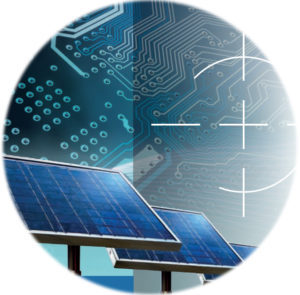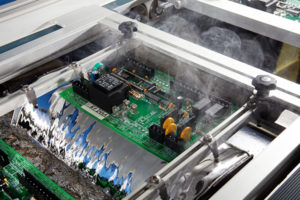The industries we supply - Electronics Industry

The electronics industry is today one of the largest global industries. Firstly we will see that celduc® relais supplies equipment to manufacture photovoltaic cells. Secondly we will see that celduc® relais supplies SSR for the semiconductors manufacturing process. Thirdly you will discover that components manufacturing process requires Solid State Relays for controlling the required temperature. Finally Solid State Relays are also widely used in equipment for manufacturing of flat-panel displays.
To sum up, for all the equipment used for these processes, Solid State Relays are the perfect solution because they can operate in harsh environments and are extremely reliable.

A photovoltaic cell (also known as a solar cell) is an electrical device that converts part of the radiant energy contained in light into electrical energy. Silicon is the base product in the manufacturing process of silicon wafer-based solar cells, which involves several stages. Our SSRs are used in the following equipment:
Diffusion furnaces, also known as thermal processing furnaces, have been widely known and used for many years to perform a variety of semiconductor fabrication processes, including annealing, diffusion, oxidation, and chemical vapor deposition. These furnaces are designed to heat semiconductor wafers to the required temperatures to either promote
diffusion of dopants to a desired depth while maintaining a line width smaller than 1 micron or to perform other conventional processing techniques such as applying an oxide layer to the wafer or depositing a chemical vapor layer to the wafer.
Solid State Relays are used for temperature control
Bare silicon wafers have a high surface reflection of over 30%. This reflection is reduced by texturing and by applying Anti Reflection Coatings (ARC) to the surface.
Solid State Relays are used for temperature control
ADVANTAGES: Using SSRs to manage heating resistors ensures precise temperature control.
Fast firing furnaces are used for burning out and sintering solar cell metal contacts. Usually, the firing area is equipped with short wave infrared light elements. After their first exposure to light, monocrystalline solar cells may suffer performance loss,
this is known as light induced degradation (LID). Therefore, a regeneration process is directly applied after fast firing.
Solid State Relays are used to control the temperature of infrared light elements.
ADVANTAGES: Phase-fired controllers (PFCs) are used to accurately regulate power.
Semiconductor annealing (heat treatment) is used to activate silicon wafers injected with impurities (increasing density/speed). The temperature must be correct at this stage. In fact, if the heat penetrates too deeply, the impurities will diffuse into deeper layers, forming a semiconductor layer that is too thick. Flash lamp annealing (FLA) limits heat treatment to the surface layer, preventing the diffusion of impurities and thereby producing very thin semiconductor layers.
During the diffusion process, dopants are added to the material.
The oxidation process forces oxygen and vapor to diffuse into the wafer surface at high temperatures between 800 and 1200°C so that a thin, smooth layer of silicon dioxide is created.
Solid State Relays are used for temperature control
Scrubber systems are designed to perform one of the most important tasks in the integrated circuit manufacturing process: wafer cleaning. It can be used between any two wafer manufacturing process steps.
These systems remove contaminants such as particles, residues and other unwanted surface defects that can cause IC device failures.
Accurate temperature control is essential because chemicals must always remain at the correct temperature before being released.
Our powerful SSRs (up to 125 A) are used to switch the heater ON & OFF, thereby maintaining a stable temperature.
Liquid cooling or air conditioning is a sensitive process that requires precision and accuracy.
Temperature control is critical during the production of semiconductors.
celduc’s Solid State Relays are the right choice!
Dry etching is used to remove layers from the surface of a wafer during the semiconductor manufacturing process. Plasma or etching gases are used to remove the substrate material.
During this process, the temperature of the substrate is an essential factor which explains why
Solid State Relays are used rather than ElectroMechanical Relays.
CVD, chemical vapor deposition, is a process that is often used in the semiconductor industry to produce thin films. The wafer (substrate) is exposed to one or more volatile precursors, which react and/or decompose on the substrate surface to produce the desired deposit.
Solid State Relays are used for temperature control
Gases have a key role to play in the electronics industry. During almost every stage of the semiconductor manufacturing process, gases are used: Deposition, photolithography, etching, doping, annealing, chamber cleaning, etc.
These systems are used to safely supply the gases required for semiconductor and solar manufacturing processes.
Accurate temperature control is essential, this is why SSRs are used to keep the gas temperature stable.

This technology is used to solder the electronic components on a PCB. This reliable and automatic process is widely used in the electronics industry.
SSRs switch the heater on & off to keep the temperature stable for the best possible soldering
Reflow soldering is another process to solder components on a PCB.
An SSR is an essential component for controlling the required temperature.
In this equipment, Solid State Relays are used for temperature control.
The service life and control accuracy of celduc®’s SSRs are essential qualities that help maintain test conditions during long test cycles.

Solid State Relays are widely used in equipment for manufacturing flat-panel displays:
to protect a screen against scratches, fingerprints, reflections, etc. This coating is applied to the substrate in liquid form and then cured in a large oven. One problem with preferred coating compositions is that the screen panel’s glass substrate cannot tolerate certain temperatures. For example, one protective coating composition cures at about 800°C and the maximum temperature the glass substrate can withstand is about 550°C before thermal damage occurs. To compensate for this, the protective coating is “cured” in an oven set at a temperature lower than that specified, but for an extremely long time.
the screen is put in a large chamber for heat treatment at 250°C ± 3°C. There are around 5 heater beams, each one is temperature controlled to maintain the correct temperature (± 3°C).